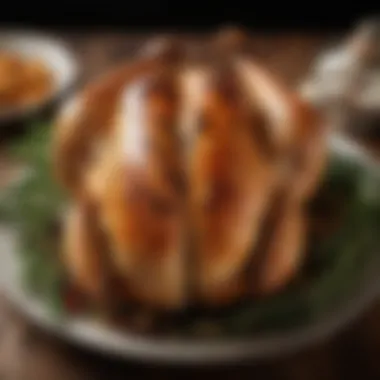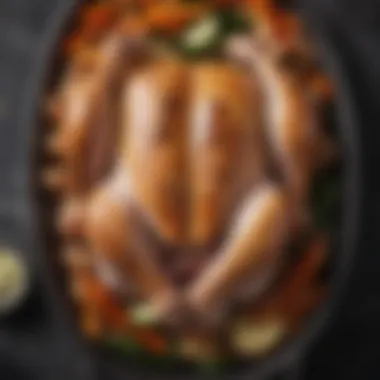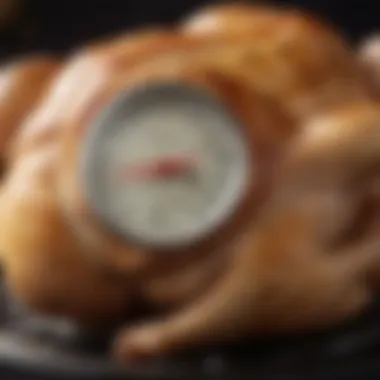How Long to Bake a Whole Chicken at 350 Degrees


Intro
Baking a whole chicken at 350 degrees Fahrenheit is a traditional method that offers a perfect blend of flavor and texture. Many people appreciate the simple, homey pleasure of a roasted chicken, and understanding the exact timing and methodology ensures success.
When considering how long to bake a whole chicken at 350, several factors play a crucial role, such as the size of the chicken and any added ingredients. A well-cooked chicken can serve as a fantastic centerpiece for family meals or gatherings, harnessing the nostalgic aromas of home cooking. This comprehensive guide aims to demystify the process, providing you with insights into precise cooking times, helpful tips, and accompanying side dishes.
Learning to bake chicken accurately will not only improve your skills but will also allow you to enjoy a dish that is both versatile and nutritious. Let’s dive into the details so you can embrace this home culinary art seamlessly.
Recipe Highlight
Our featured dish is Herb-Roasted Whole Chicken, a delightful take on classic baked chicken that celebrates the flavors of herbs and spices.
Essential Ingredients:
- 1 whole chicken (around 4-5 pounds)
- 3 tablespoons olive oil
- Salt and pepper to taste
- Fresh herbs (such as rosemary, thyme, or parsley)
- Lemon wedges (for flavor)
Estimated Time:
Preparation: 15 minutes
Cooking: 1 to 1.5 hours
Total Time: Approximately 1 hour 15 minutes to 1 hour 45 minutes
Servings: This recipe yields about 4 to 6 servings.
Step-by-Step Instructions
- Prepare the chicken: Remove the giblets from the cavity. Rinse the chicken inside and out under cold water, pat dry with paper towels.
- Season the cavity: Generously salt and pepper the inside of the chicken. Place a few lemon wedges and herbs inside the cavity to infuse flavor.
- Oil the chicken: Rub the exterior with olive oil. Sprinkle with salt, pepper, and chopped fresh herbs to enhance the flavor profile.
- Place in oven: Put the chicken breast side up on a roasting pan. Ensure there is space around the chicken for even air circulation.
- Check the cooking time: Plan for about 20 minutes per pound. A 4-pound chicken will take approximately 1 hour 20 minutes.
- Internal temperature: Use a meat thermometer. The chicken is done when the internal temperature reaches 165°F. Checking the thickest part of the thigh is best.
- Rest before carving: Let the chicken rest for 10-15 minutes before carving to allow juices to redistribute.
Tips: Frequently checking it can lead to drying. Also, avoid cutting it before resting; the flavor enclaves within.
Variations and Substitutions
You can customize the herb-roasted chicken based on your taste preferences:
- For a spicy twist, add paprika or cayenne to the seasoning.
- Swap olive oil for melted butter for richer flavor.
- Use chicken stock or wine under the chicken to enhance moisture and flavor.
Pair it traditionally with vegetables like roasted carrots or potatoes for added nutrients and taste.
Time-Saving Cooking Tips
Preparing chicken can be time-consuming if you are unorganized. Here are some tips to save you distress:
- Prep Ingredients Ahead: Chop and measure out your herbs and spices the night before. This will save time when your kitchen is busiest.
- Use Simple Tools: Utilize a broiler for one-stage cooking for crispy skin in less time.
- Meal Prepping: Consider cooking extra chicken to make multiple meals. Shredded roasted chicken is ideal for salads or soups throughout the week.
Nutritional Information
Each serving contains approximately:
- Calories: 400
- Protein: 30 grams
- Fats: 22 grams
The chicken also provides important vitamins. It’s suitable for low-carb diets and can be included in various meal plans, including paleo approaches, when accompanied by the right sides.
In summary, knowing how long to bake a whole chicken at 350 degrees can truly amplify your culinary repertoire. A perfectly crafted roast chicken has museum-style character without excessive complexity. Your efforts will reward you with great taste and nutrition.
Understanding the Basics of Baking Chicken
Baking a whole chicken can feel daunting, but understanding the basics simplifies the process. This knowledge not only enhances flavor but also ensures health and safety. Here, we spotlight key concepts that can shape the overall baking experience.
The Importance of Cooking Temperatures
Cooking temperatures are critical in achieving a safely prepared chicken. The chicken must reach an internal temperature of 165 degrees Fahrenheit, as prescribed by United States Department of Agriculture guidelines. Failure to achieve this temperature can result in foodborne illness. Maintaining the correct cooking environment also contributes to even doneness, leaving the meat juicy and flavorful.


Many inexperienced cooks may underestimate the role of temperature, believing that if the exterior looks browned, it's done. Such a belief can lead to problems. It's the inner temperature that counts. Using a meat thermometer can help eliminate guesswork and guarantee that the chicken is finally cooked.
Why Degrees Fahrenheit is Ideal
Baking chicken at 350 degrees Fahrenheit is recognized as a standard approach in many kitchens. This moderate temperature ensures even cooking without excessive drying. The skin crispens up beautifully, providing that perfect contrast to the tender meat enclosed underneath.
A few reasons highlight why this specific temperature is favored:
- Balanced Cooking Time: At 350 degrees, cooking durations can be estimated with more predictability than at higher temps, which may lead to browning before thorough cooking.
- Flavor Development: This temperature allows enough time for marinated flavors to permeate the chicken, intensifying the taste satisfaction you seek.
- Texture Retention: Baking at a moderate level preserves juiciness while creating a pleasant texture that is hard to achieve at high temperatures.
Ultimately, using 350 degrees offers balance—between moisture retention and achieving that pleasant outer crispness.
Cooking chicken to the right temperature, especially at an ideal baking temperature, makes for a delightful and secure meal.
Determining Cooking Times
Determining cooking times for baking a whole chicken at 350 degrees Fahrenheit is a central theme in achieving culinary excellence. Cooking times can greatly influence not only the texture and flavor of the chicken, but also the safety of the meal. It is crucial for cooks to understand precise cooking durations to ensure that the chicken is fully cooked and tasty.
When baking chicken, time is influenced by various factors including size, starting temperature, and the type of oven used. Evaluating these elements helps in planning the cooking process better. This guide aims to assist readers by providing transparent insights about timing, so that they can deliver a perfectly baked chicken every time.
General Guidelines for Whole Chicken Baking
Baking a whole chicken generally follows a simple formula. The common rule of thumb is baking the chicken at 350 degrees Fahrenheit for approximately 20 minutes per pound. This means a four-pound chicken could take around 1 hour and 20 minutes, whereas a five-pound bird will require close to 1 hour and 40 minutes.
While this is a helpful guideline, it is important to always check the internal temperature of the chicken using a meat thermometer. The safe internal temperature is 165 degrees Fahrenheit. This ensures the chicken is cooked thoroughly and free from harmful bacteria that could cause foodborne illnesses.
Factors Influencing Cooking Duration
Weight of the Chicken
The weight of the chicken significantly determines cooking time. A larger chicken will need more time to cook through compared to a smaller one. Cooks often notice that bigger birds tend to dry out if not monitored properly. Opting for a chicken weighing anywhere from four to six pounds is usually beneficial as these sizes yield meat that remains juicy but also cooks evenly. A 5-pound chicken strikes a balance of cooking efficiency and flavorful results.
Starting Temperature
Starting temperature also contributes to cooking duration isn’t something to be ignored. Cooking a chicken straight out of the fridge will extend the baking time as opposed to using a bird that has reached room temperature. Allowing a domestic chicken to sit outside for about 30 minutes can form a marked difference in cooking time, potentially saving 10 to 15 minutes.
Use of Convection Ovens
Using convection ovens can reduce cooking time compared to conventional ovens. Convection ovens circulate air evenly, resulting in faster and more even cooking. As such, it is wise to consider adjusting your cooking time downward by approximately 25%. However, it remains essential to monitor the internal temperature closely, as indicators might differ with various ovens. Such a method not only saves time but also creates wonderfully crispy skin.
Remember to keep your cooking practice flexible. Each chicken and oven behaves differently, so it's important to adapt as needed.
Step-by-Step Baking Process
Baking a whole chicken may seem simplistic on the surface, yet it requires a detailed approach to deliver the best results. Understanding the step-by-step baking process is crucial for achieving a succulent, well-cooked bird. This section will cover the key phases: preparation and marination, baking techniques to enhance flavor, and checking doneness with the resting period after baking. Proper attention to each aspect will not just improve taste but also contribute to the overall presentation.
Preparation and Marination
The journey to a perfectly baked whole chicken begins with preparation. Before putting the chicken in the oven, it’s essential to ensure the bird is ready for the heat. Thawing the chicken properly is the first step. If frozen, allow it to thaw in the refrigerator for at least 24 hours for best results. One must remove any giblets or organs usually found inside before cooking.
Next comes marination. Marinating the chicken provides depth of flavor. A simple mixture of oil, salt, pepper, and herbs can vastly enhance the dish. Consider using herbs like thyme, rosemary, or basil for strong flavors. It’s advisable to marinate the chicken for at least one hour, but for optimal results, overnight marination is more beneficial.
In addition, stuffing the chicken with aromatic vegetables, such as onions or garlic, can bring out additional flavors as it cooks.
Baking Techniques to Enhance Flavor
Once the preparation is completed, the baking techniques come into play. Starting at 350 degrees Fahrenheit makes for a controlled, even cook, preventing the outside from burning while the inside remains undercooked. Placing the chicken breast side up in a roasting pan with a rack allows for air circulation, ensuring even cooking.


Basting the chicken periodically throughout the baking time will also impart flavor and moisture. One could use the drippings accumulated in the pan, or mix these drippings with additional seasoned broth. It's vital never to open the oven door excessively, as it can cause the temperature to drop, prolonging cooking time.
Another key method involves covering the chicken with aluminum foil during the initial cooking phase. This traps steam, keeping the chicken moist while allowing browning to occur. After covering for about the first hour, uncovering it will allow the skin to crisp up nicely.
Checking Doneness and Resting Period
To ensure safety and taste, checking for doneness is non-negotiable. The optimal internal temperature for chicken is 165 degrees Fahrenheit. A meat thermometer is best for this purpose. Insert the thermometer into the thickest part of the thigh to assess a precise reading.
Once the chicken reaches the appropriate temperature, stop cooking immediately, as overcooked chicken becomes dry and tough. However, the work isn’t done yet. Allow the chicken to rest for about 15 to 20 minutes after removing it from the oven. This resting period is important as it allows the juices to redistribute throughout the meat, resulting in a more flavorful and tender bite.
Remember: A well-cooked chicken isn’t just about cooking; it’s about preparation, technique, and patience.
Taking the time to carefully navigate each phase not only yields a delicious dish but teaches invaluable cooking skills that enrich culinary experience. Every little decision made contributes to the final product.
Accompaniments for Baked Chicken
Accompaniments for baked chicken play a significant role in creating a well-rounded meal. While the chicken itself is often the star, the sides, sauces, and flavors that accompany it can elevate the dining experience. When one understands how to pair the right side dishes and condiments, it not only enhances the taste but also provides a contrast of textures and nutritional balance to the plate. Simplistic sides can complement roasted chicken effectively, bringing depth and roundness to the flavors already present. As one evaluates these accompaniments, taking into account the preferences of diners and their nutritional needs makes the meal more enjoyable on several levels.
Choosing Suitable Side Dishes
Selecting the right side dishes to serve with baked chicken is crucial. A wise choice can underscore the savoriness of the chicken while ensuring diners leave satisfied. Often, vegetables can provide vibrant color and nutrition alongside the chicken. Examples include roasted asparagus, baked potatoes, and steamed broccoli.
In addition, one may consider carbohydrates that can soak up juice from the chicken, such as rice or couscous. Potatoes, mashed or roasted, can add a comforting element to the meal. Culinary flexibility in choosing sides is customary as it allows one to tailor the meal based on dietary preferences. The process of selecting sides also allows for exploring various cuisines, whether it be Mediterranean through tabbouleh or Asian with a side of fried rice.
- Maintain Balance: Ensure there is a mixture of fresh vegetables and hearty components.
- Color Contrast: Combining green vegetables with golden or brown chicken is visually appealing.
- Nutritional Value: Try to maximize the health profile of your meal with whole grains and greens.
Sauces and Condiments to Elevate the Meal
The role of sauces and condiments with baked chicken cannot be overstated. They function not just as flavor enhancers, but also add a layer of complexity to each bite. Betwen creamy sauces and zesty dips, there is ample choice according to preference. Classic sauce choices include pan gravy, chimichurri, or a simple garlic butter. They enhance moisture which can be delightful over a roasted slice of chicken.
In addition to savory sauces, consider the inclusion of pickles or relishes to add a fresh-tasting tanginess. This balances the richness of the dish, bringing brightness and vibrancy.
Remember: Choosing the right sauce can transform your meal from ordinary to remarkable.
When contemplating different sauces, start by assessing how each may complement the seasoning on the chicken. A well-chosen sauce speaks well to fish, vegetables, and meats. This connection showcases your culinary acumen and will potentially impress even discerning palates. Therefore, take time to experiment until you find the perfect condiment that resonates with your vision for the meal.
Alternative Cooking Methods
Exploring alternative cooking methods is vital for understanding how variations in technique can affect outcomes in chicken dishes. Each method introduces an array of flavors, textures, and cooking times, offering new opportunities for culinary experimentation. Because taste preferences vary widely, having multiple cooking methods on hand allows cooks to adapt recipes specifically to desired results. By ensuring versatility in preparation, one can enhance their chicken experience greatly while tapping into creativity.
Roasting vs.
Baking: Key Differences
While roasting and baking often serve as interchangeable terms in cooking discourse, they embody distinct approaches to food preparation.
Baking generally refers to cooking in a steady environment at moderate temperatures, usually between 325 and 375 degrees Fahrenheit. This method suits items such as breads and pastries, as it promotes even heat distribution. By contrast, roasting involves cooking meat at significantly higher heat—typically at or above 400 degrees Fahrenheit, albeit lower heats can work depending on size. This method traditionally enhances flavors and browning, making it suitable for items like whole chickens. Roasting helps render fat while preserving moisture, resulting in a tender product. Notably, roasting may produce a wonderful crust which elevates the overall dining experience.
Slow Cooking and Its Advantages
Slow cooking offers a remarkable option when time allows it. This method can provide unfettered moisture retention and transforms tougher cuts into tender bites. By cooking over low heat for extended periods, the flavors meld seamlessly, making it a feasible alternative for busy families looking for minimal fuss.
The major benefits of slow cooking include:
- Convenience: Set it and forget it; one can manage time effectively when meal preparation requires minimal supervision.
- Flavor Development: Ingredients potentiate better with longer cooking times, achieving a deeper richness.
- Nutritional Retention: Vapor circulation keeps nutrients intact compared to extreme heat due to shorter cooking times.
- Versatility: Works for everything from soups to stews, giving cooks an inviting potential for creativity.
Grilling: Achieving Distinct Flavors


Grilling brings an entirely different element to baking methods. It introduces a smoky and charred flavor not easily present in standard oven baking. Heat applied directly from below differentiates grilling from techniques like baking or roasting. The high heat helps lock in moisture while creating a visually appealing caramelized surface.
When instructing for grilling a whole chicken, consider parameters like:
- Marination: Enhance flavors with salt and spices before cooking. This process aids not only in distribution of flavors but in preventing drying during the grilling itself.
- Temperature Management: Be alert to variations throughout the grill surface. It is often smart to keep a contained heat zone to prevent flare-ups leading to excessive char.
- Cooking Time: Typically shorter than baking, a chicken might take from 40-60 minutes depending on size and direct heat efficiency.
Approaching grilling with these techniques can offer an enjoyment level that is not just dinner; it is an unearthing of burnt endings submerged in juicy heritage flavors. Embrace grilling's full potential alongside traditional methods for the best chicken experience possible.
Alternating your cooking methods can redefine your relationship with chicken, making meals more delightful and options boundless.
Common Mistakes to Avoid
Baking a whole chicken may seem straightforward, but there are several pitfalls that can significantly impact the final result. Knowing what these common mistakes are can help ensure that your chicken comes out perfectly cooked and flavorful. Avoiding these errors not only improves taste but contributes to a more successful cooking experience overall.
Improper Preparation Techniques
Preparation sets the stage for the entire baking process. A properly prepared chicken enhances flavor and promotes even cooking. One mistake is neglecting to properly clean and pat dry the chicken before seasoning. Managing excess moisture allows the skin to crisp up nicely during baking. If your chicken is wet when it enters the oven, it can result in soggy skin instead of the desirable golden-brown appearance.
Additionally, the preparation stage is when seasoning can truly shine. Rushing through this process or under-seasoning the chicken leads to bland results. Take time to apply salt and spices generously, both on the surface and inside the cavity. A simple brine, even with salt and water, is advisable, as it helps to bolster moisture retention in the meat during baking.
Neglecting Temperature Accuracy
Temperature accuracy is critical in baking chicken. An oven thermometer is a worthwhile investment. Many household ovens can run hot or cold, influencing the cooking time and outcome. Baking your chicken at 350 degrees Fahrenheit means achieving that temperature consistently throughout the cooking process.
Overlooking the internal temperature of the chicken can lead to undercooking or overcooking. To avoid this, use a reliable meat thermometer. For a whole chicken, target an internal temperature of 165 degrees Fahrenheit measured in the thickest part of the breast. Failure to check can result in dry chicken or, worse, foodborne illness from undercooked poultry.
Skipping the Resting Phase
Many cooks think straight from the oven to the plate is the way to go with chicken, but skipping the resting phase is a vital mistake. After baking, allow the chicken to rest for at least 15 to 20 minutes before carving. This phase is necessary for redistributing the juices that built up during cooking. If you cut into the chicken too soon, the juices run out, leaving the meat dry and tough.
The resting period transforms your chicken, enhancing both texture and flavor. So invest that time; it pays off in the final product.
In summary, avoiding common mistakes such as improper prep, neglecting temperature, and skipping the resting phase greatly enhances your baking outcome.
Ending
In considering how to bake a whole chicken effectively at 350 degrees Fahrenheit, one realizes there are many vital elements to reflect upon. The baking process allows for a kitchen experience that blends practicality with taste. Each step in preparation, from seasoning to marinating, significantly contributes to the final result.
Reflecting on the journey of baking encourages one to appreciate the fill flavors and textures developed through patiently following the cooking times and techniques in the article. Keeping in mind the ideal internal temperature of 165 degrees for chicken aids in achieving safe consumption while excelling in taste.
Moreover, mastering the resting phase post-baking cannot be overlooked. It allows juices to redistribute, enhancing both succulency and flavor upon serving. Recognizing these naive yet powerful consideration informs cooking practices which tend to elevate ordinary meals into delightful family feasts.
Successful cooking embodies a careful balance of technique and creativity.
Understanding how these various components come together enables cooks to refine their approach and upgrade their kitchen skills.
Reflecting on the Baking Process
Looking back at the steps involved in baking a chicken provides insight into the blend of science and artistry within cooking. Each phase, from properly prepping the chicken to selecting the right herbs and flavors, plays a crucial role in shaping the outcome. A whole chicken baked at the right temperature leads to a satisfying meal that resonates with comfort.
Temperature management emerges as a salient factor throughout the journey. By adhering to the guidance in cooking times, and embracing the beauty of precise temperature checks, cooks can expect tender and juicy results. Reflecting on these fundamental insights often inspires a deeper understanding and appreciation of the techniques employed as well as their successful outcome.
Furthermore, evaluating side dish compatibility enhances overall meal quality. Knowing what flavors to pair with the rich character of baked chicken elevates the dining experience altogether.
Here are a few considerations:
- Focus on moisture retention during cooking
- Allow for creative liberties in seasonings and sides
- Trust the process; perfection comes with experience
Encouragement for Future Culinary Endeavors
As one feels empowered by a successful baking adventure, encouragement to press on in their culinary journey can’t be understated. Mastering the whole chicken bakes opens new avenues in the kitchen. Each recipe offers versatility that expands potential patterns of meal prep, and fosters confidence in one’s cooking style.
Exploring new recipes that build on this success can lead to creative meal ideas across various cuisines. This guide serves as a launching point for developing more comprehensive knowledge in baking and roasting. Future explorations might include trying different herbs and spices or experimenting with various cooking methods from grilling to slow roasting.
Cooks, whether novice or experienced, are encouraged to share their triumphs and failures alike in pursuit of culinary expansion. Engaging with communities both online and offline can foster a supportive environment for experimenting without fear. As expertise broadens, everyday meals transform into exciting culinary adventures that renew the joy of cooking.







